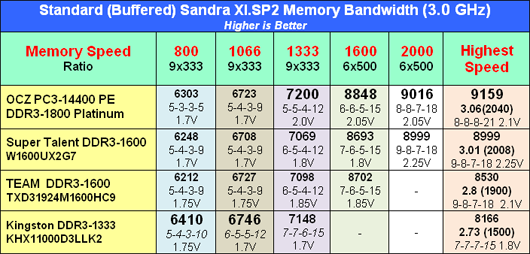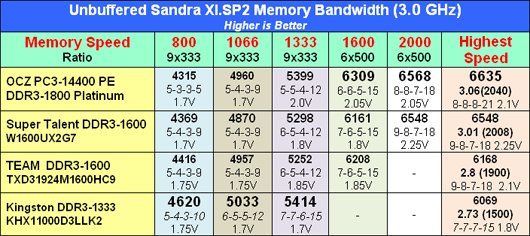Bandwidth and Memory Scaling
As you saw in the overclocking graph on page 5, the OCZ DDR3-1800 reached DDR3-2040. This is slightly higher than the Super Talent which reached DDR3-2008 and it is the highest memory speed we have yet reached with DDR3. To better understand memory performance at speeds from DDR3-800 to DDR3-2040 we compared standard or buffered bandwidth on the OCZ PC3-14400 at all standard speeds. The processor in each case was running at 3.0GHz as detailed in the memory test configuration on page 3. The OCZ bandwidth was compared to all DDR3 memory we have tested to date.
At DDR3-800 and 1066 the Elpida LL based Kingston is the best performer in the standard Sandra bandwidth test. However, at 1333 the lead shifts to the OCZ DDR3-1800 where it remains through the highest speed that could be reached with DDR3. It is interesting that the Elpida is very efficient in DDR2 overlap speeds but then loses steam at higher DDR3-only frequencies.
The new Z9 DDR3 memory owns the benchmarks from 1333 on. The Super Talent set new timing records and the OCZ extends that a bit further. The aggressive OCZ binning allows slightly faster timings at all speeds from 1333 to 2000+. In fact we were more than surprised that timings of 5-5-4-12 were stable with the OCZ PC3-14400 at 1333 speed. The Micron Z9 memory chips achieve high speeds and particularly tight timings on the OCZ memory. The TEAM memory is also based on Micron Z9 chips, and it competes well in the range it covers. Unfortunately, the binning on the TEAM has produced a memory that tops out about 100 MHz lower than the best Z9 DIMMs.
We also test memory with buffering schemes like MMX, SSE, SSE2, SSE3, etc, turned off. While these features do provide apparent improved bandwidth, the unbuffered bandwidth tends to correlate better with real-world gaming and application performance. Unbuffered performance does not always follow the patterns of buffered memory performance.
Unbuffered results show the same basic pattern as buffered results. At 800, 1066, and now 1333 speed the best unbuffered bandwidth is achieved with the Kingston LL memory. 1333 is neck and neck with the OCZ DDR3-1800 being reviewed. Above 1333 OCZ and other Micron Z9-based memory are the best performers. If you are looking for raw speed and performance it is increasingly clear that DIMMs based on Micron Z9 memory chips are the fastest DDR3 you can currently buy. There will still be variations based on the DIMM Manufacturers' experience and expertise in binning, PCB construction, and SPD programming.
As you saw in the overclocking graph on page 5, the OCZ DDR3-1800 reached DDR3-2040. This is slightly higher than the Super Talent which reached DDR3-2008 and it is the highest memory speed we have yet reached with DDR3. To better understand memory performance at speeds from DDR3-800 to DDR3-2040 we compared standard or buffered bandwidth on the OCZ PC3-14400 at all standard speeds. The processor in each case was running at 3.0GHz as detailed in the memory test configuration on page 3. The OCZ bandwidth was compared to all DDR3 memory we have tested to date.
 |
| Click to enlarge |
At DDR3-800 and 1066 the Elpida LL based Kingston is the best performer in the standard Sandra bandwidth test. However, at 1333 the lead shifts to the OCZ DDR3-1800 where it remains through the highest speed that could be reached with DDR3. It is interesting that the Elpida is very efficient in DDR2 overlap speeds but then loses steam at higher DDR3-only frequencies.
The new Z9 DDR3 memory owns the benchmarks from 1333 on. The Super Talent set new timing records and the OCZ extends that a bit further. The aggressive OCZ binning allows slightly faster timings at all speeds from 1333 to 2000+. In fact we were more than surprised that timings of 5-5-4-12 were stable with the OCZ PC3-14400 at 1333 speed. The Micron Z9 memory chips achieve high speeds and particularly tight timings on the OCZ memory. The TEAM memory is also based on Micron Z9 chips, and it competes well in the range it covers. Unfortunately, the binning on the TEAM has produced a memory that tops out about 100 MHz lower than the best Z9 DIMMs.
We also test memory with buffering schemes like MMX, SSE, SSE2, SSE3, etc, turned off. While these features do provide apparent improved bandwidth, the unbuffered bandwidth tends to correlate better with real-world gaming and application performance. Unbuffered performance does not always follow the patterns of buffered memory performance.
 |
| Click to enlarge |
Unbuffered results show the same basic pattern as buffered results. At 800, 1066, and now 1333 speed the best unbuffered bandwidth is achieved with the Kingston LL memory. 1333 is neck and neck with the OCZ DDR3-1800 being reviewed. Above 1333 OCZ and other Micron Z9-based memory are the best performers. If you are looking for raw speed and performance it is increasingly clear that DIMMs based on Micron Z9 memory chips are the fastest DDR3 you can currently buy. There will still be variations based on the DIMM Manufacturers' experience and expertise in binning, PCB construction, and SPD programming.










25 Comments
View All Comments
Mithan - Wednesday, August 1, 2007 - link
I am guessing these games were run at 800x600, which is fairly standard for memory tests?IF that is the case, then all this article does is prove once again why over-spending on memory is not the best use of your dollars (except in the case of over-clocking)
My point is this:
Farcry going from 112 to 122 FPS is probably being done at 800x600 or 1024x768.
Bump that resolution up to 1600x1200 or 1920x1200, and that becomes 1 or 2 frames per second difference.
My point is that the article should articulate this difference better.
MadBoris - Wednesday, August 1, 2007 - link
From a testing perspective of any hardware among each other, you have to isolate and remove the other bottlenecks. That should be done and is of course common sense. As you state, the main goal of these types of articles should at their very foundation stay focused on real world performance impact. Otherwise it looks too much like technology promotion and they lose their actual value to the reader. They don't have to go "real world" overboard, but I think that should be the consistent goal of hardware reviews.
Test info would be nice.
In the same vein of real world impact, the comparison should never have been between DDR3@800 compared to DDR3@2000. That's not even really applicable, the upgrade path isn't from DDR3 800, so I am not sure why the particular comparison was even made. The comparison at the very least, needs to be to current DDR2 offerings. The best case performance that DDR3 can provide right now is actually around 3 - 5 percent from current DDR2 offerings under those specific game tests (as I mentioned earlier), whatever those settings were.
Obviously testing these memory comparisons isn't simple from an apples to apples standpoint especially with limited time, so I am just glad Anandtech is getting in there and doing the testing and making their findings known. :)
Wesley Fink - Wednesday, August 1, 2007 - link
Factoring in the slower performance of current 965/975 boards on p.4 of the article, you will see that DDR3-800 on the P35 clearly beats DDR2-800 on the P965 platform. In fact, DDR3 is generally faster than DDR2-1066 at 4-4-3 timings on the P965 (the only exception being Far Cry). Taking that into account our broad statement that current DDR3 can provide as much as an 8% to 10% real world performance improvement over current DDR2 systems is certainly fair.Wesley Fink - Wednesday, August 1, 2007 - link
DDR2-800 is the fastest official JEDEC spec for DDR2, and memory running at 3-3-3 at that resolution is common among better DDR2. It is among the fastest DDR2 performance due to the fast timings. The fastest DDR2 can reach 1066 at slower timings but it cannot reach 1333.Similarly we would compare to DDR-400 at 2-2-2 looking at DDR, since this was the fastest JEDEC speed looking back at DDR. DDR3 starts at 800 and goes officially at the present time to DDR3-1600. It will likley go higher in the future.
We have compared DDR3 to one of the fastest DDR2 memories ever made at the fastest timings available for DDR2 at both 800 and 1066 in the overlap speed results on p. 4. We also did not really factor in the fact that DDR2 runs slower on the P965, P975, and other current boards than it does on the DDR2 version of the current P35 chipset.
NegativeEntropy - Tuesday, July 31, 2007 - link
I read through the article and (quickly) double checked the test config and gaming pages, but I did not see the settings the games were tested at?Wesley Fink - Wednesday, August 1, 2007 - link
All games were run at 1280x1024. That has been in past commentary, but was dropped somewhere along the way. We will add that info to the game results page.Jodiuh - Wednesday, August 1, 2007 - link
Unfortunately, you're right in the $$ issues. Those of us that would be willing to pay 2-3 times the amount for 10% gaming improvement would be better off w/ a better GPU, or even a Q66/X32 CPU for games like Supcom.Would you mind guessing what perf improvement would come from running @ say 1600x1200 or greater + 8xQ/6x AA? It'd be even less, no?
chizow - Tuesday, July 31, 2007 - link
Another underwhelming and unnecessary "update" to memory specifications. Just another example of the memory mfgs and motherboard makers forcing people to upgrade every few years for marginal performance gains. Oh well, good news is DDR2 is dirt cheap and has been for a while.LTG - Tuesday, July 31, 2007 - link
I started the complaint thread last time about the lack of comparable results, so I want to say this time:Great work, excellent article.
I was a little taken aback by your heated reaction to criticism, due to the fact that I didn't provide the solution, but hey, that's kind of human nature and I'm sure I've done it before.
The main point here is that AT not only has the best writers of any tech site, but also the only site where they are not afraid to allow feedback and actually engage debate on the issues.
Tech articles are near impossible to get perfect, because there is so many details to know and new things are discovered across the net every hour. But don't every get discouraged, the effort is all appreciated.
LTG
Wesley Fink - Tuesday, July 31, 2007 - link
Thank you for your comments. They are sincerely appreciated.